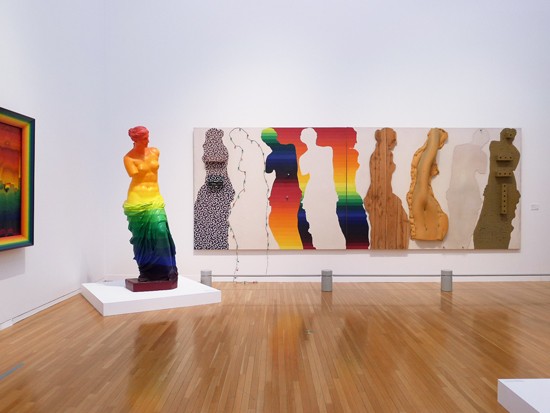Ay-O
Saturday, 28 July 2012
Work from Over the Rainbow Once More. Text courtesy Nick Faust.
“Classical busts blasted with rainbow gradients. Ay-O pushes delineated stripes to their decorative end games. Turn vertical/diagonal OP on its side and it give a spanking. His Rainbow oeuvre differs significantly in feel from his more traditional Fluxus work, but doesn’t lack that play and discovery. Birds of Paradise vibes. Add one mana of any color to your pool. Summer is here.
Ay o seems especially topical now with all of the gradient aware digital nostalgic painting that has been making the rounds in recent Mfa painting shows (Jeremy couillard Columbia, Trudy benson Pratt amongst others) and in the critical reappraisal and recent reshowing of figures like Ed paschke who predicted, if nothing more, the color scheme of the contemporary pallete. the fathead esque wall pieces by younger artists like Joshua citarella, the skins of Jon rafman (especially the recent American medium show) and prints by Manuel Fernandez all echoe back to the seminal Japanese fluxus figure at least in my eye.” –Nick Faust
Born in Ibaraki Prefecture in 1931, Ay-O, together with Masuo Ikeda and others, was active in the Demokrato Artists Association during the fifties, attracting notice for his brightly-colored oil paintings. In 1958 he moved to New York, where he used tangible objects to try to create dialogues with the world that can perceived through the senses, resulting in his ‘finger boxes’, in which a finger is inserted into a hole in the side of a box to feel the material hidden inside, installation works that incorporate their surrounding environment, etc., going beyond the confines of the painting to produce works that appeal to the five senses. During the sixties, when everyday things or actions were translated into art, Ay-O received attention for his pioneering installations that he called ‘environments’. As a member of the Fluxus movement, which went beyond the narrow divisions of genre to include musicians, poets and artists, its activities extending to performances and printed works to establish the foundations of today’s diversity of art, he worked with such people as Yoko Ono and Nam June Paik. Finally, he rebelled against the concept of creating works consisting of lines, instead filling his motifs with the colors of the spectrum, from red to purple, giving birth to his ‘rainbow’ works, becoming famous throughout the world as the ‘rainbow artist’ subsequent to his exhibition at the 1966 Venice Biennale. Ay-O’s struggle with the rainbow was expressed in a variety of genres including prints, paintings and installations, and still continues to the present day. This is the largest-ever exhibition to be held of his work, presenting numerous paintings from the rainbow series, an interactive installation that people are invited to appreciate through touch, a new work that is 30 meters in length and contains a rainbow consisting of 192 colors, a 300 meters long banner that was suspended from the Eiffel Tower in 1987 and recordings of his performance works. The gallery will overflow with Ay-O’s optimistic world. – Tokyo Museum of Contemporary Art



